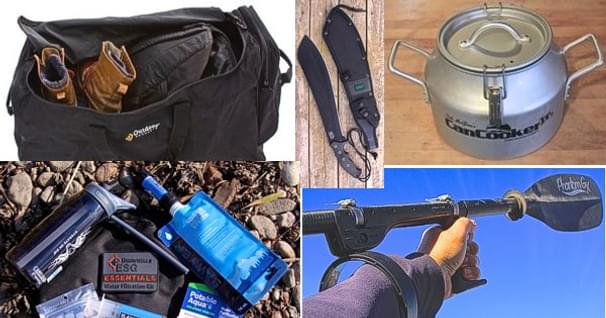How to Dry Food (part I)
Drying is probably the most ancient way to preserve food for a very long period of time. You have certainly heard about pemmican, the vital staple made by North America’s Aboriginal people using bison or venison meat, berries and buffalo fat. It was designed to be a complete food: light, easy to carry and meant to be eaten anytime, under any conditions. Thanks to those ingenuous travelers, outdoor aficionados are now enthusiastically rediscovering the simple and very efficient technique of drying foods.
Ask any paddler who navigates large bodies of water for more than, say, 3-4 days on a regular basis: they always carry a lot of dried food because without a good supply of dry provisions, such trips would be almost impossible to plan. Of course, you could survive on Kraft dinner, canned stew, canned chili and peanut butter on rye crisps for weeks, although such a regimen would probably send you into deep depression after 5 days. The truth is those canned items would be too bulky and heavy to carry on an extended trip. That’s why, usually, seasoned paddlers take along only a few cans of tuna or pork and beans for those days when they can’t cook their meal because of fatigue or bad weather. The rest of the food cargo consists of a few fresh items for the beginning of the expedition and is quickly replaced by dry items afterward. And you’d be surprised by the variety of the menu: spaghetti sauce, fruit leather, dry poultry, meat jerky, beef in red wine sauce, dry grated cheese or sausages, shrimp with curry, corned beef and potatoes, and so on. Even if you’re not a particularly talented or passionate home cook, you can easily dry your favorite canned food too.
If it’s done correctly, drying is a very safe process to keep food from spoiling since removing moisture limits the possibility for bacterial growth. Properly prepared and packaged, it also prevents molds from forming and yeast from growing. But proper packaging is crucial. I usually choose to separate a dry meal into individual portions and put each in a sturdy plastic bag. Then I remove the air with a straw, place the bag between two parchment papers and seal the bag with the help of a warm (not hot) iron. Finally, I place each bag in a Ziploc to reduce the risk of losing its precious content if the bag punctures. It also becomes another shield against humidity. You can put some dry items such as jerky or dried fruits and vegetables in airtight containers too.
Dry foods keep between 3 months (for meat) and a year without refrigeration and they usually weigh 5 to 10 times less than fresh produce. Lightweight and compact for easy packing, they reconstitute in no time with a bit of water. There are two types of dry foods: the ones you eat as such, like beef jerky, dry olives, dry cranberries; and those reconstituted by adding water. That’s the case with tomato sauce or chicken stew, for instance. Homemade dried food may take some time to prepare but they are much better and more nutritious than their commercial counterpart at a fraction of the cost and with no chemical preservatives added. And once you master the technique, drying is a breeze.
Foods can be dried in many ways: outdoor in the sun, in a homemade drying box using an electric light bulb and a fan or in a home dehydrator. This appliance is specifically built for that purpose and costs between $85 and $300. But if you are new to the technique and don’t know if you will use it often, the simplest way to proceed is by using your oven. It is somewhat less accurate and requires a bit of adjustment, but it works well too. Convection ovens are ideal because the air circulation is part of their basic function. You can achieve good results without this technology. My home oven is of the simplest kind and I’ve never had any problem drying my favorite fruit, vegetables and various recipes.
Of course, it is hard to set definite guidelines for drying time because it varies according to the thickness of the ingredients, their water content and the humidity of the surrounding air. But you can expect from 6 to 8 hours up to 24 hours for denser items. The good news is: you don’t have to stand by the oven while drying. It is a somewhat Zen process and a good lesson in patience for any home cook. Keep in mind that THERE IS NO SHORT CUT TO A SAFE AND SUCCESSFUL DRYING PROCESS. Don't try to speed up the process by turning up the oven, which is a mistake many novices attempt. The result could not only be disastrous, but also dangerous because the food would cook on the outside before it dries on the inside, which is called case hardening. This is a sure recipe for bacterial growth and mold formation.
My favorite dry foods are cherries, blueberries, tomato and spaghetti sauce, sausage, jerky, shrimps and dishes such as veal curry, chicken cacciatore and chili. But the possibilities are endless. This month I’m offering general guidelines about dry foods the simplest way. Next month, we will extend the experience by cooking and preparing different recipes from fresh fruits to jerky, vegetables and complete meals. But with the following steps, you can start your own trials right away.
Basically, there are a few general guidelines to achieve success in drying foods. Here they are:
- Food must be at their freshest and of the best quality.
- Hands, foods, cooking tools and working surfaces must be perfectly clean.
- Tools you need to dry foods in your home oven:
- cookie trays covered with sturdy plastic wrap (or parchment paper for greasy items such as sausage)
- plastic spatula instead of wooden tools to turn the items frequently.
- non-reactive cooking sheets, such as stainless steel or glass instead of aluminum.
- an oven thermometer to control the drying temperature
- Ingredients have to be cut in small pieces (bite size) to speed up the drying process
- It’s a good idea to weigh the dish you prepare twice: before and after, once dried. That way, you will know the exact amount of water to add to reconstitute it, since all the weight lost is water. If you prepare a stew, cook it, then weigh it before drying.
- Use a separate thermometer in the oven to make sure the foods are drying at a constant temperature.
7. In order to dry the food properly, keep the oven door slightly open. This allows the humidity to evaporate as the food dries. For the same reason, leave a small space between each item on the cookie sheet to allow air circulation. For sauces or stews, spread the mixture evenly in a very thin layer (half inch).
8. To make sure that your food will be drying and not cooking it is crucial that the oven temperature remains between 130° F and 150° F at all times. Usually, you can set the thermostat at 150° for the first hour and then turn it down to 130° for the remaining time. The only exception to this rule of thumb would be sauces and purees, which require 2 hours at 150° to help eliminate the large amount of water they contain. You might have to adjust the oven temperature with the help of your thermometer because home ovens are less accurate and tend to lose their heat.
9. Once foods are dried, let stand an hour for cooling, but no more to make sure moisture from the air does not re-enter the food.
10. Make sure that you store your dry food properly in airtight glass containers, in a cool, dark, dry place. Keep meat jerky in the freezer until you leave for your paddling trip, to extend its shelf life (3 months).
11. You can fill the oven with as many cookie sheets as you want. But try to dry similar items together. You can dry tomato sauce and apple sauce at the same time because their drying process is similar and neither have a strong odor. But don’t dry meat and fruit or vegetables together or with items such as shrimps or cheese. You could spoil your produce by passing on the strong aromas and tastes of other foods to them.
12. The texture of dry food varies according to the type of item you are drying: vegetables and shrimps become brittle, while fruits and jerky tend to look like leather. Dry cheese and milk will look like powder while very lean meat such as venison or turkey may be flaky.
13. To successfully dry vegetables, most of them must be blanched for best results, except for onions, tomatoes, mushrooms and peppers. For kale, cabbage, broccoli or spinach, it takes no more than one minute in a bath of boiling water. For harder vegetables such as carrots or parsnip, it takes 5-10 minutes, depending on the size of the piece.
14. Fruits are very easy to dry. Just make sure to sprinkle apples, bananas and pears with a few drops of lemon juice to prevent oxidation.
Related Articles
Each year the outdoor industry pulls back the curtain to showcase more and more "stuff" for us to drool…
In 1971, I outfitted and guided three wealthy Chicago men--the least affluent of which earned a quarter…
Kayak camping is not all that different than backpacking - if anything it is easier as you don't have to…
Christmas is just around the corner and you are again left wondering what to offer your favorite…



